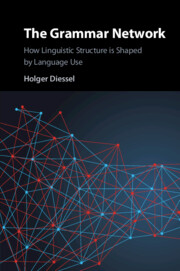Book contents
- The Grammar Network
- The Grammar Network
- Copyright page
- Contents
- Figures
- Tables
- Preface
- Abbreviations
- 1 Introduction
- Part I Foundations
- Part II Signs as Networks
- 4 The Taxonomic Network
- 5 Sequential Relations
- 6 Symbolic Relations
- Part III Filler–Slot Relations
- Part IV Constructional Relations
- References
- Author Index
- Subject Index
6 - Symbolic Relations
from Part II - Signs as Networks
Published online by Cambridge University Press: 12 August 2019
- The Grammar Network
- The Grammar Network
- Copyright page
- Contents
- Figures
- Tables
- Preface
- Abbreviations
- 1 Introduction
- Part I Foundations
- Part II Signs as Networks
- 4 The Taxonomic Network
- 5 Sequential Relations
- 6 Symbolic Relations
- Part III Filler–Slot Relations
- Part IV Constructional Relations
- References
- Author Index
- Subject Index
Summary
Chapter 6 is concerned with symbolic associations between form and meaning. Cognitive linguists have analyzed the conceptual foundations of linguistic symbols in great detail, but they usually look at the semantic pole of lexemes and constructions from a synchronic perspective. In the dynamic network approach, the focus of analysis is on the development of symbolic associations. Combining frame semantics with research on symbol learning in L1 acquisition, Chapter 6 argues that symbolic associations evolve from recurrent paths of interpretation that become entrenched in memory as a consequence of automatization. The proposed analysis challenges the traditional distinction between encoding and inference and provides the basis for a dynamic theory of meaning in which linguistic elements are seen as cues or stimuli that activate a specific concept, i.e., the figure node, of an open-ended network of world knowledge. Since the activation status of the network varies with speakers’ (and listeners’) mental states in a particular situation, linguistic cues can give rise to different interpretations in different contexts.
Keywords
- Type
- Chapter
- Information
- The Grammar NetworkHow Linguistic Structure Is Shaped by Language Use, pp. 90 - 112Publisher: Cambridge University PressPrint publication year: 2019



